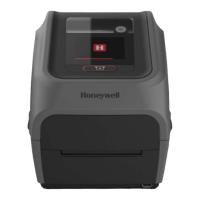
Do you have a question about the Honeywell PC45 Series and is the answer not in the manual?
| Operating Temperature | 41°F to 104°F (5°C to 40°C) |
|---|---|
| Print Technology | Direct Thermal |
| Print Resolution | 203 dpi |
| Media Types | Paper |
| Connectivity | USB |
| Operating System Compatibility | Windows, Linux |
| Power Supply | 100-240V AC, 50/60 Hz |
Overview of the printer's capabilities and specifications including speed, interface, and supported languages.
Identifies the physical components of the printer's front panel, such as the LCD screen and print/feed button.
Explains how to access and navigate the printer's main menu system for settings and functions.
Lists supported printer command languages and their simulator options like Fingerprint, IPL, and DPL.
Step-by-step guide on how to turn on and initialize the printer, including the startup wizard.
Instructions for calibrating the printer's touch screen for accurate input via the panel or web interface.
Procedures for loading various types of media into the printer, including tear-off and cut-off printing.
Step-by-step instructions for loading the thermal transfer ribbon into the printer.
Methods for connecting the printer to a personal computer using serial, USB, or Bluetooth connections.
Explains how to connect the printer to a network via Ethernet or Wi-Fi interfaces.
Instructions for configuring the printer's wireless (Wi-Fi) network settings via web page or main menu.
Instructions for accessing and logging into the printer's web interface using its IP address.
Detailed steps for configuring printer settings like communications and printing via the web interface.
Steps for installing files, fonts, and configurations onto the printer using a USB storage device.
Information on saving and loading printer configuration profiles for different media types or settings.
Table of common error alerts, their causes, and recommended troubleshooting steps.
Specific solutions for common print quality issues like weak printout or dark lines.
Procedures to reset the printer to its factory default settings via web page, main menu, or hardware reset.
Detailed instructions and precautions for cleaning the printer's printhead for optimal performance.
Step-by-step guide for safely replacing a worn-out or faulty printhead.
Instructions for replacing the printer's platen roller when it becomes damaged or worn out.
Technical details regarding compatible media types, widths, diameters, and thicknesses for the printer.
Lists the 1D and 2D barcode types that the printer is capable of generating.
Default network settings for Ethernet connectivity, including IP assignment and security.
Default configuration for system-wide parameters like name, language, time, and sleep timer.
Instructions on how to print labels using the INPrint feature via the printer's web page.
List of available accessories and optional modules that can be added to the printer.